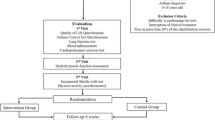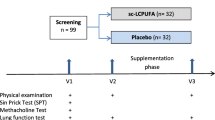Abstract
Asthma is a chronic disease that affects the lungs. Patients with asthma have obstructed and narrow lung airways which results in increased mucous in the airway wall and causes the airway to become more rigid, interfering with air flow. As the airways become obstructed, it becomes harder to breathe and the lungs fill with air. This causes chest tightness and shortness of breath. The aim of this study was to investigate the effect of an exercise programme and vitamin D supplementation (1,000 IU/day) on performance and respiratory indicators in patients with asthma. The subjects who participated in this randomized blind trial comprised 32 women with asthma. After clinical examination, the subjects’ lung volume was measured using spirometry and their activity tolerance was evaluated using the six-minute walk test (6-MWT). They were then divided into four groups, as follows: 8 weeks of aerobic exercise (AT group), aerobic exercise and vitamin D supplementation (AT+S group), vitamin D supplementation (S group), and the control group with no participation in the exercise programme and no vitamin D supplementation. The lung function parameters and activity tolerance were analysed before and at the end of the 8 weeks of aerobic exercise. The changes in forced expiratory volume in one second (FEV1) before and after the study period were +8.38, +9, −10 and −12.63 l in the AT+S, AT, S and control groups, respectively, and in forced vital capacity (FVC) were +15.13, +14.38, −6 and −13.25 l in the AT+S, AT, S and control groups, respectively. The changes in FEV1/FVC were +13.25%, +6.75%, −3%, −4.88% in the AT+S, AT, S and control groups, respectively, and the changes in the 6-MWT results were +336.37 m, +325.25 m, −17.25 m, −14.62 m in the AT+S, AT, S and control groups, respectively. There were significant differences at the end of the study period (p<0.05) in mean FEV1, FVC and 6-MWT between the AT and AT+S groups. However, FEV1/FVC was increased significantly (p<0.05) in the AT+S group. The findings of this study suggest that aerobic exercise and vitamin D supplementation for 8 weeks may improve pulmonary function and activity tolerance in asthmatic patients and could be considered as part of a pulmonary rehabilitation programme in asthmatic patients.
Similar content being viewed by others
References
Celli BR, Cote CG, Marin JM et al (2004) The body-mass index, airflow obstruction, dyspnea, and exercise capacity index in chronic obstructive pulmonary disease. N Engl J Med 350:1005–1012
Oga T, Nishimura K, Tsukino M et al (2003) Analysis of the factors related to mortality in chronic obstructive pulmonary disease: role of exercise capacity and health status. Am J Respir Crit Care Med 167:544–549
Hamilton AL, Killian KJ, Summers E, Jones NL (1996) Symptom intensity and subjective limitation to exercise in patients with cardio respiratory disorders. Chest 110:1255–1263
Gosselink R, Troosters T, Decramer M (1996) Peripheral muscle weakness contributes to exercise limitation in COPD. Am J Respir Crit Care Med 153:976–980
Mahler DA, Harver A (1992) A factor analysis of dyspnea ratings, respiratory muscle strength, and lung function in patients with chronic obstructive pulmonary disease. Am Rev Respir Dis 145:467–470
Vincken W, van Noord JA, Greefhorst AP et al (2002) Improved health outcomes in patients with COPD during 1 year’s treatment with tiotropium. Eur Respir J 19:209–216
Ikeda A, Nishimura K, Koyama H et al (1996) Dose response study of ipratropium bromide aerosol on maximum exercise performance in stable patients with chronic obstructive pulmonary disease. Thorax 51:48–53
Vempati R, Bijlani RL, Deepak KK (2009) The efficacy of a comprehensive lifestyle modification programme based on yoga in the management of bronchial asthma: a randomized controlled trial. BMC Pulm Med 9:30–37
Troosters T, Gosselink R, Decramer M (2000) Short- and long-term effects of outpatient rehabilitation in patients with chronic obstructive pulmonary disease: a randomized trial. Am J Med 109:207–212
Morgan WJ, Ellen F (2004) Results of a home-based environmental intervention among urban children with asthma. New Engl J Med 351:1068–1080
Elpern EH, Stevens D, Kesten S (2000) Variability in performance of timed walk tests in pulmonary rehabilitation programs. Chest 118:98–105
Sinha T, David AK (2003) Recognition and management of exercise-Induced bronchospasm. Am Fam Physician 67:769–774
Black PN, Scragg R (2005) Relationship between serum 25-hydroxyvitamin D and pulmonary function in the third national health and nutrition examination survey. Chest 128:3792–3798 92
Ginde AA, Mansbach JM, Camargo CA Jr (2009) Vitamin D, respiratory infections and asthma. Current Allergy Asthma Rep 9:81–87
Weiner P, Magadle R, Berar-Yanay N et al (2000) The cumulative effect of long-acting bronchodilators, exercise, and in respiratory muscle training on the perception of dyspnoea in patients with advanced COPD. Chest 118:672–678
Silva CS, Torres LAGMM, Rahal A et al (2006) Comparison of morning and afternoon exercise training for asthmatic children. Braz J Med Biol Res 39:71–78
Wasserman K (1993) Exercise tolerance in the pulmonary patient. In: Casaburi R, Petty T (eds) Principles and practice of pulmonary rehabilitation. Saunders, Philadelphia, pp 115–123
Silva CS, Torres LAGMM, Rahal A et al (2005) Evaluation of a fourth-month program of physical training designed for asthmatic children. J Bras Pneumol 31(4):279–285
Smith K, Cook D, Guyatt GH et al (1992) Respiratory muscle training in chronic airflow limitation: a meta-analysis. Am Rev Respir Dis 145:533–539
Cooper CB (2001) Exercise in chronic pulmonary disease: limitations and rehabilitation. Med Sci Sports Exerc 33(7 Suppl):S643–S646
Vassallo R, Lipsky JJ (1998) Theophylline: recent advances in the understanding of its mode of action and uses in clinical practice. Mayo Clin Proc 73:346–354
Rundell KW, Im J, Mayers LB et al (2001) Self-reported symptoms and exercise-induced asthma in the elite athlete. Med Sci Sports Exerc 33:208–213
Tattersfield AE, Town GI, Johnell O et al (2001) Bone mineral density in subjects with mild asthma randomised to treatment with inhaled corticosteroids or non-corticosteroid treatment for two years. Thorax 56:272–278
Berry MJ, Walschlager SA (1998) Exercise training and chronic obstructive pulmonary disease: past and future research directions. J Cardiopulm Rehab 18:181–191
Author information
Authors and Affiliations
Corresponding author
Rights and permissions
About this article
Cite this article
Razavi, M.Z., Nazarali, P. & Hanachi, P. The effect of an exercise programme and consumption of vitamin D on performance and respiratory indicators in patients with asthma. Sport Sci Health 6, 89 (2011). https://doi.org/10.1007/s11332-011-0102-5
Received:
Accepted:
Published:
DOI: https://doi.org/10.1007/s11332-011-0102-5




